| Click here
for a free downloadable article entitled "Noni
cultivation in Hawaii." |
| NOTE: Many of
Hawaii’s noni growers shared their knowledge and experience
with the author of this web site. Statements here about noni
cultivation are not intended as explicit recommendations but
rather as suggestions based on growers’ experience. |
 |
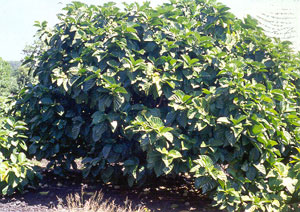 |
|
Propagation of Noni
Noni is propagated either from seed or stem cuttings. The primary
disadvantage of seed propagation is that without seed treatment,
germination takes 6-12 months or more, whereas stem cuttings
can be rooted in approximately 1-2 months. The disadvantage
of producing plants vegetatively from cuttings is that they
may not be as strong and disease-resistant as seedlings, and
the trunk and branches may split and break during the first
years of fruit production. |
Cultivation from
seed
Note: For more detailed information about noni seeds and their processing and germination, click here for a free downloadable article entitled "Hawaiian Noni Seed Processing and Germination." [PDF, 657 KB]
Noni seeds are reddish-brown, oblong-triangular, and have a
conspicuous air chamber. They are buoyant and hydrophobic due
to this air chamber and their durable, water-repellant, fibrous
seed coat. The seed coat is very tough, relatively thick, and
covered with cellophane-like parchment layers. A single large
noni fruit can contain well over 100 seeds. |

A single noni seed free of fruit flesh. Note the conspicuous
air chamber (light brown-colored bubble) in the upper-right
hand portion of this seed. |
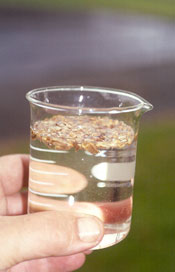
Noni seeds can float for many weeks. |
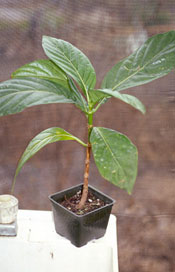
Young noni plant grown from seed in a 4-inch pot. |
| Back to Top |
| Only soft, ripened noni fruits should be chosen
for seed collection. The seeds must be separated from the fibrous,
clinging fruit flesh. First, split the fruit by hand into smaller
pieces. Separate the seeds from the flesh using a strong spray
of water and a firm screen or colander, washing the pulp through
the screen while retaining the cleaned seeds. Rubbing the fruit
fragments on the screen by hand or with a blunt object can help
force the fruit flesh through the screen. It may take 15 minutes
or more of vigorous washing and rubbing to detach most of the
flesh from the seeds. |
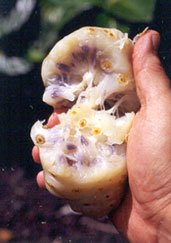
Ripened noni fruit with seeds. A single fruit may have hundreds
of seeds. |
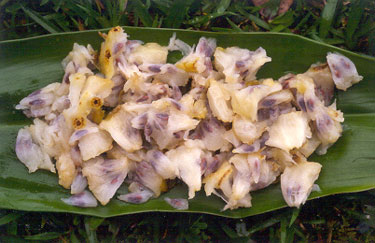
Ripened noni fruits break up easily by hand, but the pulp clings
to the seeds. To obtain noni seeds for planting, they may be
planted with the pulp attached, or the pulp may be separated
from the seeds first. The seeds may be dried or not dried before
planting. |
| Seed scarification. Scarifying the hard
seed coat by nicking or puncturing it significantly reduces
germination time, improves germination percentage, and promotes
uniform sprouting. Whereas in nature the seed coat must gradually
decompose before water can enter, scarification overcomes this
natural seed dormancy. Using a household blender to separate
seeds from the ripened fruit flesh can also result in nicking
the seed coats, or the seeds can be suspended in water and subjected
to short pulses of blending. |
| Seed drying and storage. Noni seeds can
be dried and stored, but the length of time they will remain
viable is not known. After cleaning, spread the seeds out on
newspaper and dry them in the shade or indoors for two or three
days. Store the seeds in an air-tight container at room temperature.
|
| Planting. Fresh noni seeds can be planted
immediately after extraction from the fruit. Some growers soak
the seeds until they start to germinate, then plant them in
containers, while others plant fresh seeds without presoaking
treatment. The seedlings are usually grown for about nine months
to a year before they are transplanted to the field. Some growers
just plant fruit fragments containing seeds directly into the
field soil. |
Germination. Noni seeds require hot, wet
conditions for optimum germination. Un-scarified seeds require
several months to a year before natural germination takes place,
but their germination can be reduced to a month or so using
heat. The seeds can tolerate temperature of 100°F (38°C),
perhaps even higher. Select the warmest spot in the nursery
or greenhouse to germinate noni seeds. Or, heat can be supplied
using nursery heating pads under the seed flats, or by placing
the flats or containers in a special “hoop house”
covered with clear plastic. If germinated outside, partial sun
is preferable to full sun to avoid excessive drying of the medium.
Noni seeds may be germinated in seedling flats or trays or sown
directly in containers. A light medium that retains water yet
remains aerated is best. Suitable components for a planting
medium include vermiculite, perlite, peat moss, commercial potting
media, compost, and fine volcanic cinder. For seedling flats,
use a light medium, such as one part each of perlite and peat
moss, or perlite, vermiculite, and potting soil in a 2:1:1 ratio.
For containers, a slightly heavier medium is better, such as
one part of perlite or vermiculite and three parts of a potting
mix. Fertilizers should not be mixed into the medium, because
additional nutrients are not needed until after the plants have
their first true leaves. |
| Growth media. Artificial growth media
are preferred to field soil for germinating and growing out
noni seedlings. These relatively sterile media give the plants
the cleanest start, whereas soil (particularly agricultural
field soil) tends to contain pathogens that cause plant diseases.
For example, many agricultural soils are infested with root-knot
nematodes, and noni is highly susceptible to the disease (known
as noni root-knot disease) caused by these microscopic, parasitic
worms. |
Growth containers. Deeper seedling flats
are preferred to shallow flats, because seedlings with longer
tap roots are produced. Seedlings with deep, well established
taproots tend to withstand the shock of transplanting better
and become established more quickly than seedlings with short
misshapen (“J-rooted”) taproots. Seedlings may be
planted directly into larger containers or transplanted from
the seedling bed into pots.
When seeds are germinated in flats, they should be transplanted
into growing containers within a few weeks of germinating. The
plant size and vigor achieved depends to a large extent on the
size of pot used—the larger and deeper the pot, the larger
and more vigorous the noni seedling. “Gallon” pots
(about 6 inches in diameter at the top) provide sufficient rooting
volume to produce large, healthy seedlings for transplanting.
Noni plants can become pot-bound and stop growing if the pot
is too small or shallow or they are grown for more than 9–12
months. Fortunately, noni is a vigorous plant with a strong
root system that can easily recover from pot-bound conditions
once transplanted into suitable field conditions. |
Seedling care. Generally, noni seedlings
are grown in pots for a minimum of 9–12 months in full
sun before they are transplanted to the field. Seedlings up
to 3 years old or more may also be planted.
Seedlings and young plants grown from cuttings can be given
liquid fertilizer once a month, or a controlled-release fertilizer
less often (depending on the formulation’s release period).
Balanced formulations such as 14-14-14 that also contain micronutrients
(“minor elements”) are advised. Young plants also
respond well to applications of dilute, liquid foliar fertilizers.
As plants become established, granular, rapidly soluble formulations
can be used. Noni is relatively salt-tolerant, and fertilizer
burn is uncommon under normal conditions. |
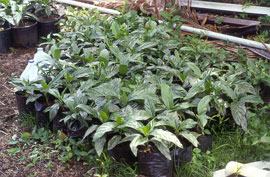 |
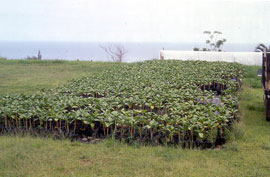 |
Noni seedlings ready for transplanting
into the field.
These plants are grown in black plastic, 1-gallon perforate
grow bags. |
| Back to Top |
 |
Vegetative Propagation |
Cultivation of noni
plants from stem cuttings (verticals or laterals) reduces the
time required to obtain plants that are ready for transplanting.
Cuttings from stems and branches will sprout roots readily under
the proper conditions. A rooting compound may prove helpful
in promoting rapid root establishment.
Select vigorous plants for stem propagation. Remove a branch
or stem and check for fresh sap flow from the wound. If the
sap flows readily, cuttings could be made from these materials.
If sap does not ooze from the cut ends, discard the material
and select another plant, another location, or perhaps wait
for a better time of year. Sap flow indicates a vigorous, actively
growing plant with relatively high reserves of energy.
Insert the cut end of the freshly cut noni stem into a pot containing
a general-purpose growth medium. Again, an artificial, pathogen-free
medium is preferred to untreated agricultural field soil. Select
a location with partial shade and keep the cuttings well watered
until rooting occurs. After rooting, move the plants into full
sun and begin fertilizer applications. |
| Noni plants may be produced by stem
cuttings. |
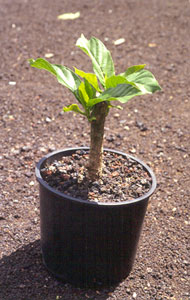
Vertical stem cutting in a cinder-soil mix, sprouting new side
branches.
|
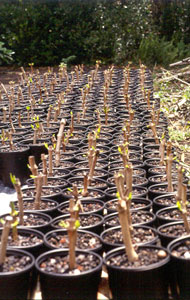
Vertical stem cutting in a cinder-soil mix, sprouting new side
branches.
|
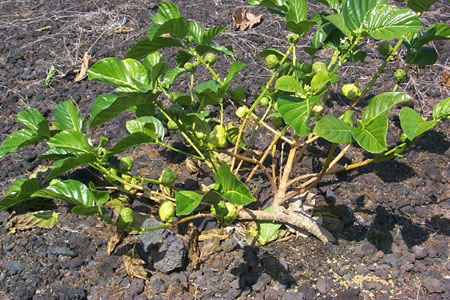
Young noni plant derived from a lateral stem cutting. Plants
derived from lateral stem cuttings tend to grow in a prostrate
habit and may be susceptible to splitting of branches when the
fruit load is heavy. Farmers choose to make plants from cuttings
because it can save a significant amount of time from planting
to first harvest. |
| Back
to Top |
| Noni plants may also be produced
by air layering or by digging up plants that have sprouted from
seed of having sprouted from the root system of a mature plant
(see below). |
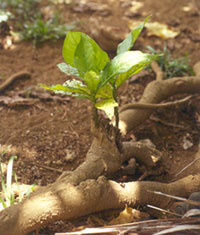
Noni foliage may sprout from the roots of mature noni plants,
as shown above. By severing the segment of root, digging it
up with the attached foliage, and planting it, a new noni plant
(clone) may be obtained. |
 |
Field cultivation |
- Site selection
Avoid locations where other crops have been planted recently,
due to the susceptibility of noni to root-knot nematodes.
Select a site in full or partial sun with well drained,
well aerated soil. Avoid heavy soils, compacted areas, and
flood-prone sites. Prepare a hole about the size of the
pot and transplant carefully. In rocky locations, “rip”
the land (disturb or plow the sub soil) before grading to
prepare a flat or gently sloping field.
- Windbreaks
Young noni transplants do not grow well where winds are
strong. Such conditions may exist along windward coasts;
on the Island of Hawaii parts of the Hamakua coast and Kau
are very windy. If a windy site is selected for noni cultivation,
windbreaks should be planted for protection. Trees such
as eucalyptus, ironwood, or wili-wili planted 150 feet apart
are excellent windbreaks for noni. Noni is not adversely
affected by planting near ironwood.
- Varieties
No cultivated varieties of noni are recognized in Hawaii,
and no germplasm collections are known of anywhere. Another
species, Morinda trimera, resembles M. citrifolia
but has smaller leaves and fruits. M. citrifolia
var. potteri is a noni with variegated, green-and-white
leaves.
Among noni plants grown in Hawaii, there appears to be significant,
heritable variability in fruit size, shape, and number of
seeds. This suggests that through selection, improvement
for desirable noni fruit traits can be achieved.
- Planting spacing
An appropriate interplant spacing for noni is 10–15
feet. At 12-foot spacing there are 290 noni plants per acre.
Higher planting densities (closer plant spacing) result
in crowding and may exacerbate certain pest or disease problems.
- Soils
Noni is an unusual plant, because it can easily tolerate
and thrive in a wide range of soils and conditions. In Hawaii
it can grow under almost any soil conditions at low altitudes.
- Pruning
Young plants less than 3 years old may be pruned back after
or during their first production of fruit. In the following
years, the pruned plants will become bushy. Because noni
trees can reach a height of approximately 20 feet, growers
may wish to prune the vertical branches of mature plants
to facilitate fruit harvest. Pruning is an effective means
of disrupting conditions conducive to pest and disease outbreaks.
- Nutrition and fertilizer
The amount of nutrients and frequency of fertilizer applications
required by noni depends on the soil and rainfall. Noni
trees growing in forests usually appear healthy without
the benefit of any artificial fertilizers. This suggests
that noni may require only small amounts of fertilizer to
grow well. In general, however, if intensive fruit production
is desired in an agricultural setting, a fertilizer program
is recommended. Research is needed to develop the best fertilizer
regimes for noni production in the various regions of Hawaii
where noni might be grown. It is suspected that noni will
do best with relatively frequent applications of small amounts
of fertilizer. Noni, being salt-tolerant, will also tolerate
high levels of fertilizer salts in the root zone without
damage or burning to the plant.
The strategy for providing nutrients to noni is similar
to that for other fruit crops such as citrus of coffee.
Young, non-fruiting noni plants are encouraged to produce
lush vegetative growth with balanced fertilizers such as
14-14-14 or 16-16-16, whereas more mature or flowering/fruiting
plants are encouraged to produce many large fruits by applying
high-phosphorous fertilizers such as 10-20-20 or 1-45-10.
Young seedlings and transplants are given controlled-release
formulations, while older, mature plants are given rapidly
available granular formulations. Fertilizer should be applied
away from the trunk of the tree, at the “drip line”
of the plant, the area where water drips from the edge of
the leaf canopy.
Noni plants of all ages respond well to sprays of foliar
fertilizers. Noni flower and fruit production is very responsive
to sprays of high-phosphorous foliar fertilizers (e.g.,
10-45-10) and products (e.g., seaweed emulsions) containing
nitrogen and minor elements.
Noni should be fertilized frequently using smaller amounts
of fertilizer, rather than infrequently using larger amounts.
In high-rainfall areas, young plants up to a year old can
be given _ pound per month of balanced fertilizer (14-14-14),
and more mature plants can be given up to 1 pound per month.
Effective organic fertilizers for noni cultivation include
crushed coral, dolomite, K-mag, 7-7-7, and composted chicken
manure and macadamia nut husks. Some locations will benefit
from yearly applications of lime, about 1 pound per plant.
- Irrigation
Noni thrives with moderate irrigation and can survive extended
periods of drought once established and mature. When plants
are less than 2-3 years old and conditions are dry, irrigate
once or more a week, applying up to 10 gallons per plant;
for older plants, irrigate less frequently. Over-watering
can accelerate damage to noni from root-knot nematodes,
cause root rot, and leach fertilizer nutrients beyond the
root zone. |
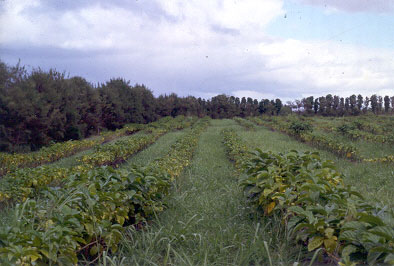
Noni cultivation in deep soil (on former sugar cane plantation)
near Honoka’a on the Hamakua coast of the Big Island of
Hawaii. This farmer chose 1-foot plant spacing between plants
within rows. Weed control is the biggest problem facing farmers
who plant noni on the Hamakua coast or in deep soils in Hawaii.
|
| Click
here for more noni cultivation photos. |
| Back to Top |
|

